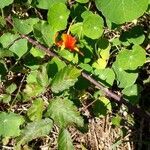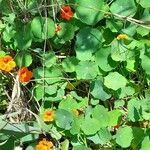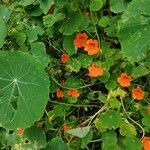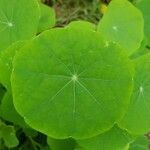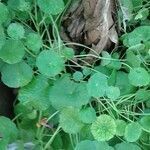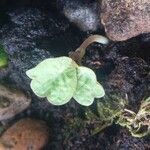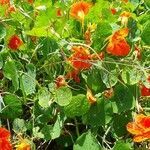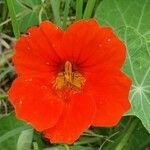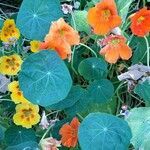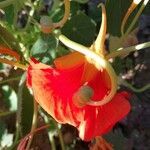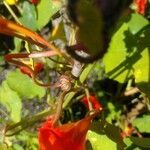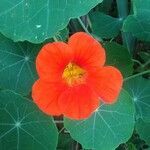Climbing or prostrate annual vine, often stout or almost fleshy, normally glabrous. Leaves rarely somewhat pubescent at base; petioles to 15-20 cm long; laminae large, to 10 by 10 cm or more, suborbicular, peltate with 7-11 unforked principal nerves, the margin entire or undulate, the apex in adult leaves not mucronate. Flowers single; peduncles of the same length as the petioles or shorter; calyx lobes lanceolate, acute, 15-18 mm long, basally 8-9 mm broad, the superior lobes somewhat smaller, like the spur often yellowish green or green; spur stout, inflated in the lower half, darker apically, slightly curved, 25-35 mm long; superior petals cuneate, somewhat undulate, emucronate, 30-40 mm long, inferior petals unguiculate, ciliate, the blade 15-20 by 15-20 mm, the claw 12-15 mm long, nerves and maculation from light lemon to blackish purple. Fruiting carpels to 10 mm long, fleshy, with rugose ribs.
Herbs, annual, trailing, glabrous or nearly so. Leaf blade orbicular to somewhat reniform, 3-10 cm in diam., peltate and with 9 main nerves radiating from petiole, margin variously angled or sinuate but otherwise entire, abaxial surface usually papillose. Flowers axillary, solitary, yellow, orange, purple, maroon, creamy white, or varicolored, 2.5-6 cm in diam. Pedicel 6-13 cm. Torus cup-shaped. Sepals 5, oblong-lanceolate, 1.5-2 × 0.5-0.7 cm; spur 2.5-3.5 cm, straight or curved. Petals 5, apex mostly rounded but sometimes shortly pointed or even toothed; apical 2 petals 2.5-5 × 1-1.8 cm, margin often entire; basal 3 petals with margin deeply fringed on claw. Stamens 8, distinct, unequal. Ovary 3-loculed; style 1; stigma linear, 3-lobed. Fruit oblate, separating into 3 1-seeded mericarps at maturity. Fl. Jun-Oct, fr. Jul-Oct. 2n = 28.
Herb, perennial (sometimes annual), trailing or climbing, with stems to c. 2 m long or more. Leaves peltate; petioles to 20 cm long, attached slightly eccentrically; blades c. circular to reniform, 3–13 cm diam., with c. 9 main radiating veins, often waxy, sparsely glandular to pilose beneath; pedicels c. equal to petioles or slightly longer. Flowers yellow, orange or red, usually streaked darker internally. Calyx 12–20 mm long (excluding spur); lobes free for 8–15 mm; spur narrowly conical, 18–35 mm long. Petals obovate to c. orbicular, 12–25 mm diam.; upper pair with claw glabrous, 2–6 mm long; lower 3 with claw bearded, 5–10 mm long. Stamens about as long as claws of lower 3 petals. Style shorter than stamens. Mericarps ±semicircular, 7–10 mm long, ribbed dorsally, slightly fleshy.
Plants trailing, 15-100(-250) cm; glabrous or glabrate. Leaves: petiole 5-25 cm; blade with ca. 9 veins radiating from petiole, 3-10(-12) cm diam., abaxial surface usually papillose. Pedicels 6-13(-18) cm. Flowers 2.5-6 cm diam.; sepals light brown, oblong-lanceolate, 1.5-2 × 0.5-0.7 cm; spur straight or slightly curved, 2.5-3.5 cm; petals yellow, orange, purple, maroon, creamy white, or varicolored, mostly rounded, apex sometimes acuminate or emarginate, proximal 3 petals 2 × 2 cm, distal 2 petals usually entire, 2.5-5 × 1-1.8 cm, claw to 1.5 cm, claw margin deeply fringed; stamens 0.5-0.6 mm; anthers 0.5 mm; style 0.5-0.6 cm; stigmas 0.6-0.9 mm. Fruits oblate, 1.5-2 cm diam. Seeds 5-8 mm diam. 2n = 28.
Annual herb, up to 0.3 m high; slightly succulent. Stems trailing or climbing, up to 1 m long. Leaves glabrous; blade orbicular, variable in size, ± 30-150 mm in diameter, margins entire or shallowly lobed, upper surface green, prominently veined, lower surface paler; petioles up to 300 mm long. Flowers: solitary on long pedicels; corolla 25-60 mm in diameter, dark orange, shades of red and yellow or yellow with red markings; Oct.-Apr. Fruit of 3 mericarps; seeds elongate, 10-15 mm long.
A creeping climbing annual herb. It grows to 60-300 cm high and can spread to several m wide with long branches. The leaves are small and round. They are light green. Leaves are 2.5-6 cm across. The edges of the leaves are wavy. The veins radiate out from the centre. It has trumpet like flowers. The flowers are orange and yellow and have a pointy piece at the back of the flower. Several ornamental varieties have been bred by hybridisation.
